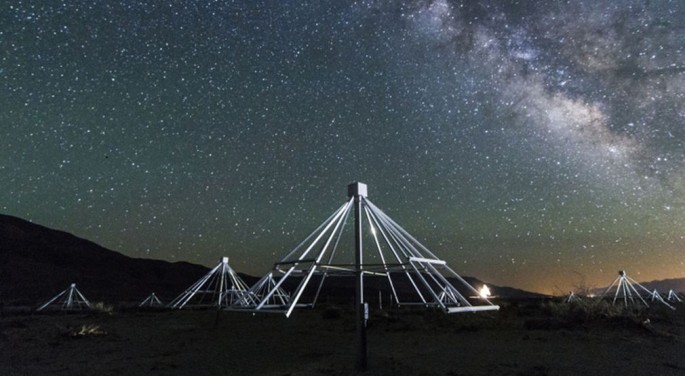A new radio telescope array that can simultaneously image the entire sky at radio wavelengths with unmatched speed can help astronomers peer into the evolution of the early Universe.
Developed by a consortium led by Caltech and now operational at the Owens Valley Radio Observatory, the "Owens Valley Long Wavelength Array" (OV-LWA) is already producing unprecedented videos of the radio sky.
Astronomers hope it will help them piece together a more complete picture of the early Universe and learn about extrasolar space weather, or the interaction between nearby stars and their orbiting planets.
OV-LWA is a remote Long Wavelength Array site with over 250 antennas spread out over a desert area equivalent to about 450 football fields near Big Pine, California.
"Our new telescope lets us see the entire sky all at once, and we can image everything instantaneously," said Gregg Hallinan, OV-LWA's principal investigator and an assistant professor of astronomy at Caltech.
Combining the observing power of more than 250 antennas, the OV-LWA is uniquely sensitive to faint variable radio signals such as those produced by pulsars, solar flares and auroras on distant planets.
A single radio antenna would have to be a hundred meters wide to achieve the same sensitivity (the giant radio telescope at Arecibo Observatory in Puerto Rico is 305 meters in diameter).
OV-LWA holds great promise for cosmological studies and might allow astronomers to watch the early universe as it evolved over time.
Scientists might then be able to learn how and when the Universe's first stars, galaxies, and black holes formed. But the formative period during which these events occurred is shrouded in a fog of hydrogen opaque to most radiation. Even the most powerful optical and infrared telescopes can't peer through that fog.
By observing the sky at radio frequencies, however, astronomers might be able to detect weak radio signals from the time of the birth of those first stars and galaxies.
"The biggest challenge is that this weak radiation from the early universe is obscured by the radio emission from our own galaxy, which is about a million times brighter than the signal itself, so you have to have very carefully measured data to see it," said Hallinan.
"That's one of the primary goals of our collaboration -- to try to get the first statistical measure of that weak signal from our cosmic dawn."
If they're able to detect that signal, researchers could be able to learn about the formation of the first stars and galaxies, their evolution, and how they eventually ionized the surrounding intergalactic medium, to give us the Universe we observe today.
"This new field offers the opportunity to see the universe evolve, in a cosmological movie of sorts," Hallinan noted.
But Hallinan is most excited about using the array to study space weather in nearby stellar systems similar to our own.
Our Sun occasionally releases bursts of magnetic energy from its atmosphere, shooting X-rays and other forms of radiation outward in large flares. Sometimes these flares are accompanied by shock waves called coronal mass ejections, which send particles and magnetic fields toward Earth and the other planets.
Light displays, or auroras, are produced when those particles interact with atoms in a planet's atmosphere. These space weather events also occur on other stars, and Hallinan hopes to use the OV-LWA to study them.
"We want to detect coronal mass ejections on other stars with our array and then use other telescopes to image them," he said. "We're trying to learn about this kind of event on stars other than the Sun and show that there are auroras caused by these events on planets outside our solar system."
The consortium that built and operates the OV-LWA includes astronomers from Caltech, JPL, Harvard University, the University of New Mexico, Virginia Tech, and the Naval Research Laboratory.



























